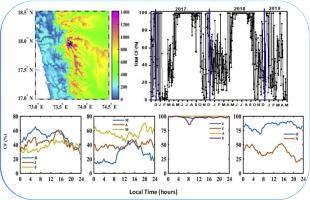当前位置:
X-MOL 学术
›
Atmos. Res.
›
论文详情
Our official English website, www.x-mol.net, welcomes your
feedback! (Note: you will need to create a separate account there.)
Diurnal (24 h) cycle and seasonal variability of cloud fraction retrieved from a Whole Sky Imager over a complex terrain in the Western Ghats and comparison with MODIS
Atmospheric Research ( IF 4.5 ) Pub Date : 2021-01-01 , DOI: 10.1016/j.atmosres.2020.105180 Sneha Sunil , B. Padmakumari , G. Pandithurai , Rohit D. Patil , C.V. Naidu
Atmospheric Research ( IF 4.5 ) Pub Date : 2021-01-01 , DOI: 10.1016/j.atmosres.2020.105180 Sneha Sunil , B. Padmakumari , G. Pandithurai , Rohit D. Patil , C.V. Naidu

|
Abstract Continuous monitoring of cloud fraction (CF) using a Whole Sky Imager (WSI) equipped with an infrared (IR) camera, play a crucial role in validating satellite data and numerical models. WSI is operated at a high altitude station located in the complex terrain of Western Ghats (WG) of peninsular India from December 2016 to May 2019. CF is retrieved continuously for 24 h at a high temporal resolution (5 min) and a unique time series is constructed for thick, thin, and total cloud cover. The retrieved CF is compared with MODIS (Aqua and Terra satellites) CF during the overpass times over the study area. Good correlation is observed, however, more bias is observed during broken/partial clouds. The biases also arise due to the viewing angles, sensor field of view, and sensitivity of the measurement techniques. The diurnal (24 h) cycle of total CF showed high variability in all the seasons except in monsoon where 90–100% CF is observed throughout the season. The post-monsoon and winter showed high variability due to the occurrence of unusual cyclonic systems in the Arabian Sea as well as in the Bay of Bengal. The temporal monthly mean CF showed significant variability in day and night, with bi-modal and mono-modal distributions in winter and pre-monsoon, respectively during day time, while nights showed mostly flat distribution. Thin CF is also observed in all the months and showed high irregular variability in the range of 2–6%. On a seasonal scale, the observed CF is 50%, 45%, 100%, 60% for winter, pre-monsoon, monsoon and post-monsoon, respectively. The difference in day and night CF is observed only during winter with day CF more than night CF. The study infers that cloud events/characteristics observed on a temporal scale get averaged out on diurnal, monthly, and seasonal scales. When compared with MODIS diurnal and seasonal variability, large biases are observed on a regional scale due to high CF variability, and more importantly, fewer satellite observations representing the day average.
中文翻译:

从全天成像仪在西高止山脉复杂地形上获取的云分数的昼夜(24 小时)循环和季节性变化,并与 MODIS 进行比较
摘要 使用配备红外 (IR) 相机的全天成像仪 (WSI) 连续监测云分数 (CF) 在验证卫星数据和数值模型方面发挥着至关重要的作用。2016 年 12 月至 2019 年 5 月,WSI 在位于印度半岛西高止山脉 (WG) 复杂地形的高海拔站运行。 CF 以高时间分辨率(5 分钟)和独特的时间序列连续检索 24 小时为厚、薄和总云量而构建。在研究区域的立交时间内,将检索到的 CF 与 MODIS(Aqua 和 Terra 卫星)CF 进行比较。观察到良好的相关性,但是,在破碎/部分云期间观察到更多偏差。由于视角、传感器视场和测量技术的灵敏度,也会出现偏差。除了在整个季节观察到 90-100% CF 的季风外,总 CF 的昼夜 (24 小时) 循环在所有季节都显示出高度可变性。由于阿拉伯海和孟加拉湾出现了不寻常的气旋系统,季风后和冬季表现出很大的变化。时间月平均 CF 在白天和晚上表现出显着的变化,在冬季和季风前,白天分别具有双峰和单峰分布,而夜间则大多呈平坦分布。在所有月份也观察到薄 CF,并显示出 2-6% 范围内的高度不规则变化。在季节性尺度上,冬季、季风前、季风和季风后观测到的 CF 分别为 50%、45%、100%、60%。白天和夜间 CF 的差异仅在冬季观察到,白天 CF 比夜间 CF 多。该研究推断,在时间尺度上观察到的云事件/特征在日、月和季节尺度上得到了平均。与 MODIS 的日变化和季节变化相比,由于高 CF 变化,在区域尺度上观察到大偏差,更重要的是,代表日平均值的卫星观测较少。
更新日期:2021-01-01
中文翻译:

从全天成像仪在西高止山脉复杂地形上获取的云分数的昼夜(24 小时)循环和季节性变化,并与 MODIS 进行比较
摘要 使用配备红外 (IR) 相机的全天成像仪 (WSI) 连续监测云分数 (CF) 在验证卫星数据和数值模型方面发挥着至关重要的作用。2016 年 12 月至 2019 年 5 月,WSI 在位于印度半岛西高止山脉 (WG) 复杂地形的高海拔站运行。 CF 以高时间分辨率(5 分钟)和独特的时间序列连续检索 24 小时为厚、薄和总云量而构建。在研究区域的立交时间内,将检索到的 CF 与 MODIS(Aqua 和 Terra 卫星)CF 进行比较。观察到良好的相关性,但是,在破碎/部分云期间观察到更多偏差。由于视角、传感器视场和测量技术的灵敏度,也会出现偏差。除了在整个季节观察到 90-100% CF 的季风外,总 CF 的昼夜 (24 小时) 循环在所有季节都显示出高度可变性。由于阿拉伯海和孟加拉湾出现了不寻常的气旋系统,季风后和冬季表现出很大的变化。时间月平均 CF 在白天和晚上表现出显着的变化,在冬季和季风前,白天分别具有双峰和单峰分布,而夜间则大多呈平坦分布。在所有月份也观察到薄 CF,并显示出 2-6% 范围内的高度不规则变化。在季节性尺度上,冬季、季风前、季风和季风后观测到的 CF 分别为 50%、45%、100%、60%。白天和夜间 CF 的差异仅在冬季观察到,白天 CF 比夜间 CF 多。该研究推断,在时间尺度上观察到的云事件/特征在日、月和季节尺度上得到了平均。与 MODIS 的日变化和季节变化相比,由于高 CF 变化,在区域尺度上观察到大偏差,更重要的是,代表日平均值的卫星观测较少。











































 京公网安备 11010802027423号
京公网安备 11010802027423号